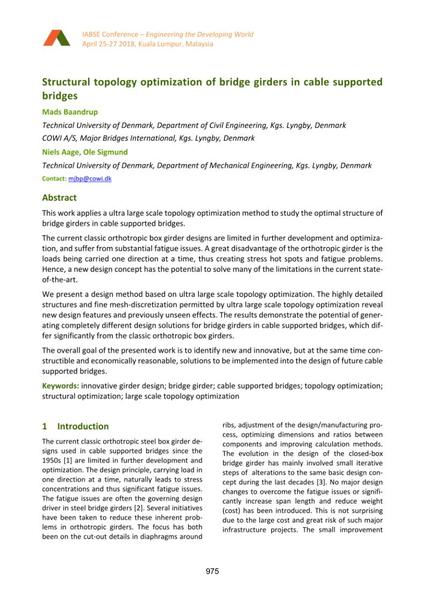Structural topology optimization of bridge girders in cable supported bridges

|
|
|||||||||||
Détails bibliographiques
| Auteur(s): |
Mads Baandrup
Ole Sigmund (Technical University of Denmark, Department of Mechanical Engineering, Kgs. Lyngby, Denmark) Niels Aage (Technical University of Denmark, Department of Mechanical Engineering, Kgs. Lyngby, Denmark) |
||||
|---|---|---|---|---|---|
| Médium: | papier de conférence | ||||
| Langue(s): | anglais | ||||
| Conférence: | IABSE Conference: Engineering the Developing World, Kuala Lumpur, Malaysia, 25-27 April 2018 | ||||
| Publié dans: | IABSE Conference Kuala Lumpur 2018 | ||||
|
|||||
| Page(s): | 975-982 | ||||
| Nombre total de pages (du PDF): | 8 | ||||
| DOI: | 10.2749/kualalumpur.2018.0975 | ||||
| Abstrait: |
This work applies a ultra large scale topology optimization method to study the optimal structure of bridge girders in cable supported bridges. The current classic orthotropic box girder designs are limited in further development and optimiza tion, and suffer from substantial fatigue issues. A great disadvantage of the orthotropic girder is the loads being carried one direction at a time, thus creating stress hot spots and fatigue problems. Hence, a new design concept has the potential to solve many of the limitations in the current state of-the-art. We present a design method based on ultra large scale topology optimization. The highly detailed structures and fine mesh-discretization permitted by ultra large scale topology optimization reveal new design features and previously unseen eff ects. The results demonstrate the potential of gener ating completely different design solutions for bridge girders in cable supported bridges, which dif fer significantly from the classic orthotropic box girders. The overall goal of the presented work is to identify new and innovative, but at the same time con structible and economically reasonable, solutions tobe implemented into the design of future cable supported bridges. |
||||
